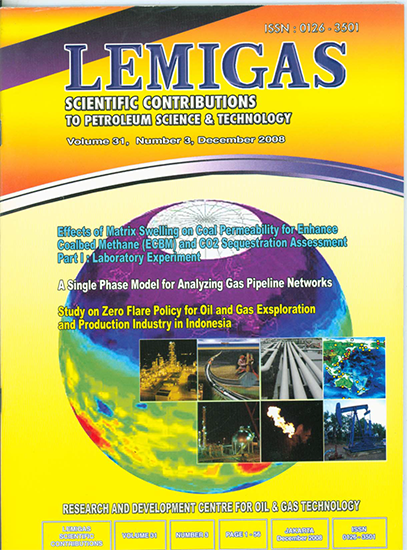STUDY ON ZERO FLARE POLICY FOR OIL AND GAS EXPLORATION AND PRODUCTION INDUSTRY IN INDONESIA
DOI:
https://doi.org/10.29017/SCOG.31.3.1011Keywords:
Environmental, Gas Flaring, Zero Flare and Re-injection.Abstract
Flaring is an essential practice in oil and gas production, primarily for safety reasons. Although data indicate that, on a worldwide basis, gas flaring contributes only 1% of anthropogenic carbon dioxide emissions, for environmental and resource conservation reasons, flaring should always be minimized as much as practicable. In the frame work of Global Gas Flaring Reduction Public-Private Partnership (GGFR), Government of Indonesia (GOI) through Directorate General of Oil and Gas is preparing a draft policy for Green Oil and Gas Industry Initiative (GOGII). GOI encourage oil and gas activity in Indonesia to be environmental friendly industries by implementing Zero Flare, Zero Discharge, Clean Air and Go Renewable programs. Zero flare can be achieved by different kind of methods, such as re-injection of associated gas, gas utilization on-site, and collection and market to downstream markets. This paper tries to review and evaluate the possibility of implementing the zero flare policy for oil and gas exploration and production industries in Indonesia, in the frame work of contributing to GOI in preparing draft policy for GOGII.
References
Paserba, K. R., Gellman, A. J., 2001, Kinetics and energetics of oligomer desorption from surfaces. Phys. Rev. Lett. 86, 19, 4338-4341.
Ammann, M., Pöschl, U and Rudich, Y., 2003, Effects of reversible adsorption and LangmuirHinshelwood surface reactions on gas uptake by atmospheric particles, J. Phys. Chem. 5, 351-356.
Tielens, F and Geerlings, P., 2002, Adsorption energy surfaces in faujasite type zeolites Adsorption energy surfaces in faujasite type zeolites, Chem. Phys. Lett. 354, 474-482.
Bishop, A. .R.; Girolami, G. S.; Nuzzo, R. G. 2000,Structural models and thermal desorption energetics for multilayer assemblies of the n-alkanes on Pt(111), J. Phys. Chem. B 104 , 4, 754- 763.
Bartels, T., Eichler, B., Zimmermann, P., Gäggeler, H., Ammann, M., 2002, The adsorption enthalpy of nitrogen oxides on crystalline ice, Atm. Chem. and Phys. 2, 235-247.
Orita, H., Uchida. K and Itoh.N., 2004, A volcano-type relationship between the adsorption energy of thiophene on promoted MoS2 clustermodel catalysts and the experimental HDS activity: ab initio density functional study, Appl. Catal. A: General, 258, 1, 115-120.
Hsieh,C.T and Chen, J.M., 2002, Adsorption energy distribution model for VOCs onto activated carbons, J. Coll. Interface Sci. 255, 2, 248-253
Paserba, K.R; Gellman, A. J., 2001, Effects of conformational isomerism on the desorption kinetics of n-alkanes from graphite. J. Chem. Phys. 115, 14, 6737-6751.
Downloads
Issue
Section
License
Copyright (c) 1970 SCIENTIFIC CONTRIBUTIONS OIL AND GAS (SCOG)

This work is licensed under a Creative Commons Attribution 4.0 International License.
Authors are free to Share — copy and redistribute the material in any medium or format for any purpose, even commercially Adapt — remix, transform, and build upon the material for any purpose, even commercially.
The licensor cannot revoke these freedoms as long as you follow the license terms, under the following terms Attribution — You must give appropriate credit , provide a link to the license, and indicate if changes were made . You may do so in any reasonable manner, but not in any way that suggests the licensor endorses you or your use.
No additional restrictions — You may not apply legal terms or technological measures that legally restrict others from doing anything the license permits.














